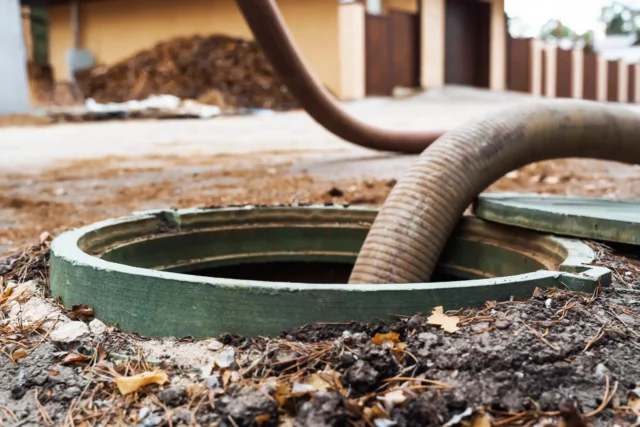Algae blooms are a common yet troubling issue in many water bodies, ranging from lakes to ponds and rivers. While there are several factors that contribute to these blooms, one often overlooked source is the septic tank.
Understanding how your septic system can influence algae growth is crucial for maintaining both your septic system and the health of nearby water sources. This guide will walk you through the connections between septic tanks and algae blooms, the environmental impacts, and how proper maintenance can help.
How Does A Septic Tank Contribute To Algae Blooms In Nearby Water Sources?
Septic tanks are designed to treat household waste by separating solids from liquids. However, when these systems are not properly maintained, they can become a significant source of nutrient pollution, which fuels algae blooms. Here’s how:
- Nutrient Leaks: If a septic tank is malfunctioning or has a leak, it can release nutrients such as nitrogen and phosphorus into the ground. These nutrients can eventually seep into nearby water bodies.
- Overflows: In cases where septic systems are overloaded or not functioning correctly, the excess waste can flow into surface waters.
- Inadequate Drainage: If the drain field or leach field of a septic system is not properly designed or maintained, it may not adequately absorb and filter out waste, leading to nutrient runoff into surrounding water sources.
What Are The Environmental Impacts Of Algae Blooms Linked To Septic Systems?
Algae blooms have several detrimental effects on the environment and ecosystem. When these blooms are fueled by nutrients from septic systems, their impacts can be particularly severe:
- Oxygen Depletion: When algae die and decompose, the process consumes large amounts of oxygen in the water. This can lead to hypoxic (low-oxygen) conditions, which are harmful to aquatic life, such as fish and invertebrates.
- Toxicity: Some types of algae produce toxins that can be harmful or even fatal to wildlife, pets, and humans. These toxins can contaminate drinking water and affect the safety of recreational water activities.
- Disruption of Ecosystems: Algae blooms can disrupt the natural balance of aquatic ecosystems. They may outcompete other plants for sunlight and nutrients, leading to reduced biodiversity and changes in the habitat.
Can Septic Tank Maintenance Help Prevent Algae Blooms In Surrounding Water Bodies?
Proper maintenance of your septic system is key to preventing it from contributing to algae blooms in nearby water bodies. Here are some maintenance practices to consider:
- Regular Inspections: It is recommended that you have a professional inspect your septic system at least once every one to three years minimum. This makes it more likely that any problems will be recognized and remedied before they develop into more significant inconveniences.
- Pump Out Periodically: Septic tanks should be pumped out regularly to remove accumulated solids. This helps prevent overflows and backups that can lead to nutrient leaks.
- Avoid Overloading: Be mindful of the volume of wastewater your septic system handles. Avoid excessive water use and don’t flush non-biodegradable items that can disrupt the system’s function.
- Proper Drain Field Care: Ensure that the drain field is properly maintained and not compromised by excessive traffic, heavy structures, or root intrusion from nearby trees.
What Role Do Septic Tanks Play In Water Pollution And Algae Growth?
Septic tanks play a significant role in water pollution and can contribute to algae growth if not properly managed. Here’s how they impact water quality:
- Nutrient Pollution: Septic systems that are not functioning correctly can release excessive amounts of nitrogen and phosphorus into the environment. These nutrients act as fertilizers for algae, leading to blooms.
- Pathogen Contamination: Malfunctioning septic systems can also release pathogens into nearby water sources, which can be harmful to both human health and aquatic life.
- Surface Water Impact: Wastewater from septic systems can flow into surface water bodies, contributing to pollution and exacerbating algae growth issues.
By understanding the connection between septic tanks and algae blooms, you can take proactive steps to ensure your septic system does not negatively impact nearby water sources. Regular maintenance and mindful usage of your septic system are crucial in preventing pollution and protecting the health of your local water bodies.
FAQs About Service Costs
1. What factors influence the cost of septic tank services? The cost of septic tank services can vary based on several factors, including the size of your septic system, the type of service required (e.g., inspection, pumping, repair), and the condition of your system. Our team will provide a detailed estimate after evaluating your specific needs.
2. Are there any additional fees for emergency services? Yes, emergency services may incur additional fees due to the urgency and off-hours work. However, we strive to keep our rates transparent and reasonable, ensuring you are aware of any extra costs before proceeding.
3. Do you offer any discounts or financing options? We do offer seasonal discounts and financing options to help manage the cost of our services. Contact us to inquire about current promotions and financing plans that may be available to you.
4. How often should I schedule septic tank maintenance to avoid high costs? Regular maintenance is key to preventing costly repairs. We recommend scheduling a professional inspection and pumping every 1-3 years, depending on your system’s size and usage.
Get in Touch Today!
Protect your septic system and local water sources with expert care from Honeybee Septic Tank Service. Contact us today to schedule a consultation or request a quote. Our team is ready to address your septic system needs and help prevent algae blooms. Call us or visit our website to get started!
